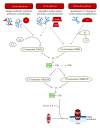Complement Attack against Aspergillus and Corresponding Evasion Mechanisms
- PMID: 22927844
- PMCID: PMC3423931
- DOI: 10.1155/2012/463794
Complement Attack against Aspergillus and Corresponding Evasion Mechanisms
Abstract
Invasive aspergillosis shows a high mortality rate particularly in immunocompromised patients. Perpetually increasing numbers of affected patients highlight the importance of a clearer understanding of interactions between innate immunity and fungi. Innate immunity is considered to be the most significant host defence against invasive fungal infections. Complement represents a crucial part of this first line defence and comprises direct effects against invading pathogens as well as bridging functions to other parts of the immune network. However, despite the potency of complement to attack foreign pathogens, the prevalence of invasive fungal infections is increasing. Two possible reasons may explain that phenomenon: First, complement activation might be insufficient for an effective antifungal defence in risk patients (due to, e.g., low complement levels, poor recognition of fungal surface, or missing interplay with other immune elements in immunocompromised patients). On the other hand, fungi may have developed evasion strategies to avoid recognition and/or eradication by complement. In this review, we summarize the most important interactions between Aspergillus and the complement system. We describe the various ways of complement activation by Aspergillus and the antifungal effects of the system, and also show proven and probable mechanisms of Aspergillus for complement evasion.
Figures
References
-
- Denning DW. Invasive aspergillosis. Clinical Infectious Diseases. 1998;26(4):781–803. - PubMed
-
- Speth C, Rambach G, Würzner R, Lass-Flörl C. Complement and fungal pathogens: an update. Mycoses. 2008;51(6):477–496. - PubMed
-
- Ellis M. Invasive fungal infections: evolving challenges for diagnosis and therapeutics. Molecular Immunology. 2002;38(12-13):947–957. - PubMed
-
- Rüping MJGT, Vehreschild JJ, Cornely OA. Patients at high risk of invasive fungal infections: when and how to treat. Drugs. 2008;68(14):1941–1962. - PubMed
LinkOut - more resources
Full Text Sources


